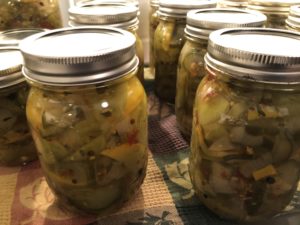 © 2020 Donna Hébert, all rights reserved
© 2020 Donna Hébert, all rights reserved
My Nana made sweet pickles, not sour ones. Until I was at college and ordered a sub, my taste for pickles ran sweet. Truth to tell, it still does. It has to be a really good half-sour to grab me and forget those deep-fried dill pickles. Ummm . . . why would you take something already crispy and fry it flaccid? Food fail!
There was nothing improvisational about Nana’s pickles or piccalilli but they were delicious. There were no fancy flavorings (she was Acadian – we’re lucky they were salted). She used just the basics – sugar, salt, vinegar and pickling spices – but hers were the pickle I judge all other pickles against, even my own.
I hadn’t canned anything in years but my first summer at Bob’s homestead, he had a large cucumber, green tomato, and pepper crop at the end of August. I put on an apron, dug out Ball’s Blue Book from his cookbook shelf, channelled my Nana and went to work. We just finished the last jar of those 2017 pickles, the one with the hot peppers. Good thing we’re making more. This year there will be a whole batch of hot pickles!
 (Bob Hartman-Berrier photos, above, the flower garden at The Farm, and the breathtaking view of the Gulf of St. Lawrence; below – Looking up the hill)
(Bob Hartman-Berrier photos, above, the flower garden at The Farm, and the breathtaking view of the Gulf of St. Lawrence; below – Looking up the hill)
We had planned on a big garden this year but of course, plans changed, we just got here, and it’s too late for a garden. We looked around to see what was available for produce. Russ Daigle’s produce at The Farm in Terre Noire is all organic. Even in a lean year, this is a very impressive garden, especially as it’s perched on a rather inhospitable slope south of Chéticamp right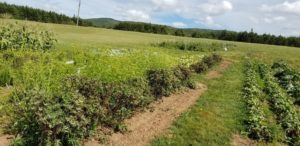 on the coast. The wind she blow, you know? If we’d arrived just a day earlier, the ferocious winds wouldn’t have allowed us to stand up straight on his hill. If you know the island, you know I’m not exaggerating. Russ’s corn hadn’t quite broken but it was growing sideways.
on the coast. The wind she blow, you know? If we’d arrived just a day earlier, the ferocious winds wouldn’t have allowed us to stand up straight on his hill. If you know the island, you know I’m not exaggerating. Russ’s corn hadn’t quite broken but it was growing sideways.
Russ saves his seed for The Farm and doesn’t use starter plants, even for herbs or flowers. Given our six-month residency here for now, starting plants indoors won’t work for us but I can ask and maybe he’ll sell us a few plants next year when we arrive. With his land sloping uphill from the ocean, I also wonder if he’s figured out which cultivars will grow best under a strong west wind!
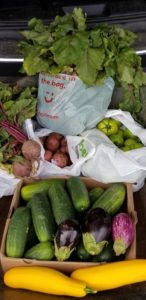 Bob and I spent an hour or so washing, slicing and brining the veg, listening to my buddies from Barachois sing and play Acadian music – in honor of Nana, of course! This year’s pickles have cukes (seeded – look at the size of those puppies!), onions, green tomatoes, yellow zucchini, and red
Bob and I spent an hour or so washing, slicing and brining the veg, listening to my buddies from Barachois sing and play Acadian music – in honor of Nana, of course! This year’s pickles have cukes (seeded – look at the size of those puppies!), onions, green tomatoes, yellow zucchini, and red 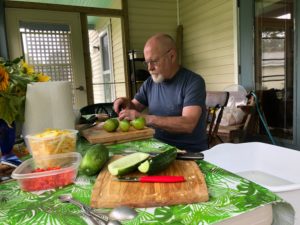 pepper for color. You understand that cooks always use what’s at hand. The pickles have brined for about two hours so it’s time to drain and rinse them a few times.
pepper for color. You understand that cooks always use what’s at hand. The pickles have brined for about two hours so it’s time to drain and rinse them a few times.
Bread and Butter Pickles 2020
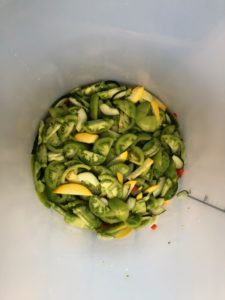 A batch = six-seven pounds of processed veg – sliced, mixed, salted, brined, rinsed, rinsed again, and drained. There was almost a gallon of brine left from a double batch. Weigh the processed veg and set aside in a bowl. It’s easier than you think and Bob showed me how. Weigh yourself and a large-enough container, then add the veg and weigh again until the difference is six-seven pounds.
A batch = six-seven pounds of processed veg – sliced, mixed, salted, brined, rinsed, rinsed again, and drained. There was almost a gallon of brine left from a double batch. Weigh the processed veg and set aside in a bowl. It’s easier than you think and Bob showed me how. Weigh yourself and a large-enough container, then add the veg and weigh again until the difference is six-seven pounds.
In a separate large pot – bigger than you think you might need, bring 3 cups of sugar and 4.5 cups of white vinegar to a rolling boil, adding 3-4 tablespoons of pickling spice (I always add extra mustard seed and this year, a teaspoon of red pepper flakes for zing) stirring until the sugar is dissolved and the solution bubbles up.
Add the veg you rinsed, drained and weighed, and mix well, getting the spices into every corner. If, at this point, the liquid doesn’t cover the veg, add more sugar and vinegar until it does. I had to do this so I increased the amount of vinegar in my recipe, adding a proportional amount of sugar, but not more spices. My proportions were 1 cup of vinegar to ⅔ cup of sugar. Cover, bringing it back to a rolling boil (this is why you use a larger pot – it won’t boil over) for long enough to make the pickles translucent but not have them fall apart. Mine took about 15 minutes. That was a lot of veg, around 15 pounds, cooked in two batches and canned in three.
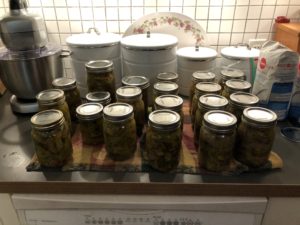 Pack the hot pickles in sterilized jars. Make sure the liquid comes to 1/2 inch from the top and push any stray veg back down. Shake the jar gently to remove air bubbles, wipe the rim clean with a damp paper towel, cap the jar and process for 10 minutes in boiling water. Here’s what today’s sweet and hot bread and butter pickles look like – 18 pints, 2 half pints and one quart!
Pack the hot pickles in sterilized jars. Make sure the liquid comes to 1/2 inch from the top and push any stray veg back down. Shake the jar gently to remove air bubbles, wipe the rim clean with a damp paper towel, cap the jar and process for 10 minutes in boiling water. Here’s what today’s sweet and hot bread and butter pickles look like – 18 pints, 2 half pints and one quart!
 We still have enough cukes for another big batch of just cucumber pickle and enough beets for who knows how many batches of pickled beets. Russ (Bob photo) wanted to give us the food and Bob wisely wouldn’t let him. We want to come back and savor his bounty at The Farm again next year. He’s 76 and when people ask him how he can do this at his age, he replies “because I do this at this age,” a slogan for all of us, right?
We still have enough cukes for another big batch of just cucumber pickle and enough beets for who knows how many batches of pickled beets. Russ (Bob photo) wanted to give us the food and Bob wisely wouldn’t let him. We want to come back and savor his bounty at The Farm again next year. He’s 76 and when people ask him how he can do this at his age, he replies “because I do this at this age,” a slogan for all of us, right?